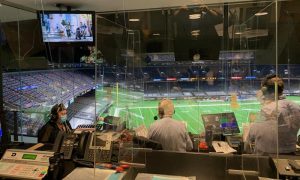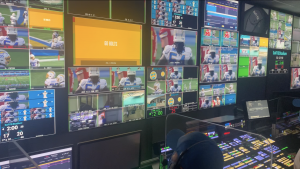On the Gridiron: Inside an NFL Franchise’s Game Day Production in 2020
Crews are juggling a lot of responsibilities and challenges this year
Story Highlights
Years from now when the NFL looks back at the 2020 season in the history books, readers will be astonished by the laundry list of logistical obstacles that in-venue professionals had to overcome. In a non-bubble environment, crews have flipped the switch to overdrive to bring at-home and a small number of in-person fans a semi-normal experience. SVG’s On the Gridiron Series takes you behind the scenes to learn the production workflows of various organizations.
MORE ON THE GRIDIRON INTERVIEWS
- In Between Games, JungleVision Productions Sets the Table With Bengals Weekly
- Chicago Bears Fuel Content Train With Remote Workflows, Safe Crewing at Soldier Field
- Tennessee Titans’ Behind-the-Scenes Video Efforts Embodied by ‘Tennessee Tough’ Campaign
- Seattle Seahawks Production, Ops Teams Keep Fans at the Heart of Game Day at CenturyLink Field
- Silver and Black Productions, Las Vegas Raiders Build New Roots During Allegiant Stadium’s Inaugural Season
- Philadelphia Eagles Embrace Virtual Workflows for Efficient Regular-Season Strategy
- New York Giants Entertain At-Home Fans With Daily Digital, Linear Programming
- While SoFi Stadium Remains Empty, Los Angeles Chargers Refine Production Workflows
- Atlanta Falcons Acclimate to Evolving Set of COVID-19 Policies at Mercedes-Benz Stadium
- Minnesota Vikings Adjust Content Approach at High-Tech U.S. Bank Stadium
- How the Kansas City Chiefs Celebrated Super Bowl LIV, Displayed Moment of Unity Before 2020 Season Opener
- Carolina Panthers’ Mike Bonner Gets Settled in New Role Amid Interesting Circumstances
- Indianapolis Colts Facilitate Remote Radio Broadcasts of Away Games from Lucas Oil Stadium
- Baltimore Ravens Adjust In-Game Operations To Feed More Content to Digital, Social Platforms
- After Busy Offseason, Denver Broncos Welcome Limited Fans Back to Empower Field at Mile High in Week 3
- San Francisco 49ers Production Team Shifts Gears To Engage the Players
- Jacksonville Jaguars Reflect on In-Stadium Fans During Week 1, Connecting With ‘Duval’ Community
- Without Raucous Crowds, New Orleans Saints Adapt to a Quiet Mercedes-Benz Superdome
Out of the Gate: Kansas City Chiefs, Jacksonville Jags Begin Season With Limited Attendees
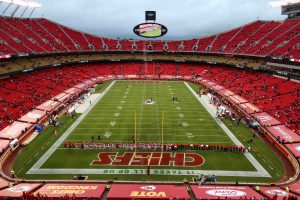
The Chiefs and the NBC broadcast team adjusted their script to fit in the moment of unity after the national anthem.
Over a month ago on Thursday, Sept. 10, there were still a boatload of unknowns at the beginning of the season. Although there was a certainty that a larger percentage of the NFL stadiums would play Week 1 without fans, there were still two teams that decided to host fans for their home openers: the Kansas City Chiefs and the Jacksonville Jaguars.
In the case of the defending Super Bowl champions, the Chiefs pushed to have fans in seats to display the pageantry and festivities that comes with their 2019 accomplishment. While the pregame celebration was high on their to-do list, the impromptu plan by Chiefs quarterback Patrick Mahomes and Texans quarterback Deshaun Watson to display a sign of unity before the game caused for last-minute changes to run of show.
“We ended up changing all of our timing for the pregame,” says Kristen Pugh, manager of game and event entertainment, Kansas City Chiefs. “We also had to meet with [SNF Executive Producer] Fred Gaudelli and with people from the league after our rehearsal on Wednesday. It turned out beautifully, and I wouldn’t have wanted to work so hard and put in the extra time, effort, and energy that it took to make that happen [with any other team]. Most of the shots that were seen on the broadcast were seen in the stadium because we worked so closely with Fred to make sure that we were streaming at the same time and were connected on timing.”
Down in Florida, the Jaguars weren’t celebrating a victory in last year’s championship game, but they did have to sidestep a handful of hurdles on that Sunday afternoon. Prior to the first game, Production Manager Carlos Caceres and his colleagues did multiple sound checks and other tests in TIAA Bank Field
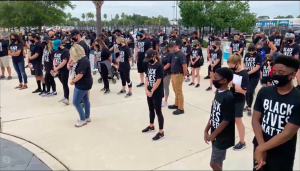
One of the franchise’s most successful live streams, the player-organized Black Lives Matter march was viewed on the Jaguars’ social-media feeds.
“While we were waiting for some direction, we bought some decibel meters and coordinated with our events team, football operations, and myself in the booth to play the soundtrack out into the bowl,” he says. “We were walking around and getting different readings on the main concourse, field level, pool deck, etc., and before the league mandated [crowd noise], we got to an internal agreement.”
Similar to the Chiefs, the Jaguars also participated in gesture that supported social justice reform. Albeit conducted during the summer, adjustments made on the fly made this demonstration one of the highest performed live stream ever.
“It was a really cool experience and that’s something that the organization supports,” continues Caceres. “Our routine conversations revolve around building diversity, inclusion, community outreach, activism, voting, and social justice. I’ve been here since 2009 and I don’t think we’ve ever done anything like that. Hopefully, we continue to do more of that.”
In-Venue Sound: League Continues to Find the Audio Sweet Spot
Caceres and the team with the Jaguars aren’t the only individuals who have continued to tinker with the fabricated audio being played in the stadium. Clubs in Major League Baseball were the first to experiment with fake crowd noise over their own sound system, so in an effort to keep the game feel as authentic as possible, NFL Films has supplied control rooms with a dynamic and curated audio track with team-specific chants, cheers, and more.
One of the new options to play is booing or miscellaneous sounds of disapproval. During the initial slate of games, the New Orleans Saints went viral when their audio operator played noise that reacted negatively toward a penalty called against the defense.
“[Saints cornerback] Marshon Lattimore and [Buccaneers wide receiver] Mike Evans, who have been going at it for a couple of years now, went at it again and our crowd noise operator played some boos, which made it feel like a real game,” says Kyle Campbell, director of game day experience, New Orleans Saints. “It was important for us to identify someone to help run that dynamic audio that knows what a game in the Superdome feels like.”
For venues that are known to be loud and deafening, like Mercedes-Benz, this new audio baseline could help bring some life back into a building with loyal Saints fans. Unfortunately, Campbell and company weren’t able to crank up the volume during their Week 1 matchup against Tom Brady and the Tampa Bay Buccaneers due to a league-mandated policy that forbids noise to exceed 70 decibels during gameplay.
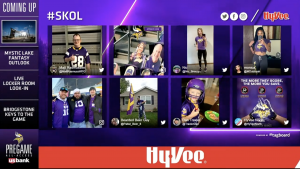
Vikings Entertainment Network has used live video shows to both drive engagement with fans and bring value to sponsors.
“The ambient crowd noise needed to stay at the same level the entire game and we couldn’t fluctuate it from our standpoint,” he adds. “We miss that home field advantage, but we’re trying to get creative to make sure that we are creating an advantage for our team.”
Luckily, the league abolished this restriction after two weeks of harsh criticisms from viewers. Since the opening week, teams are benefitting from this rule change by leveraging their unique environments with in-attendance fans, including another team situated in an enclosed stadium, the Indianapolis Colts in Lucas Oil Stadium.
“It’s a pretty fast improvement,” says Mike Stevens, operations manager of video engineering, Indianapolis Colts. “There has been a lot of positive feedback with being allowed to expand upon our music, stingers, PA [messaging], and prompts. We’re able to push a little harder to get the fans and players going. It was a really nice thing for the league to lift that [rule], but we’re still keeping an eye on it just because we don’t want to blow 7,500 people’s ears out with loud music.”
Getting Creative: Teams Accelerate Content Creation, Remote Broadcasts for At-Home Fans
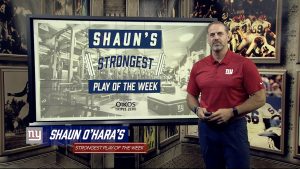
Oikos Strongest Play of the Week with Shaun O’Hara is among the content streamed exclusively on digital platforms.
Despite in-venue shows running without the pulse of fans, content creation has been through the roof this year. Known for developing content surrounding the team, the New York Giants are combining their linear and digital avenues to establish a cohesive and cross-platform initiative.
On MSG Networks and WWOR-TV, Head Coach Joe Judge and Bob Papa break down some of the most critical offensive, defensive, and special teams plays of the past week on The Joe Judge Report on Mondays. On Friday, Saturday, and before the game on Sunday, Giants First & 10 sets the table with the ten most important storylines and matchups to watch. Giants Access Blue, a behind-the-scenes, off-the-field, backstage magazine show, airs on Saturday night. After the game, the Giants Postgame Wrap-Up puts a bow on the action. For a bit of nostalgia that is unrelated to the upcoming game, the weekend is packed with episodes of Giants Chronicles, a 30-minute show that recaps some of the greatest moments and players in the organization’s illustrious 95-year history.
On the team’s website at Giants.com, the Giants Mobile App, the Giants YouTube channel, and various social media accounts, televised material is repurposed and digital exclusives are produced, including Oikos Strongest Play of the Week, 2 Minute Drill, Sights and Sounds, Above the Numbers, Audible, Crossfire, and as an added personal touch, Know Your Giant with current players.
Up north in Minnesota, the folks with Vikings Entertainment Network are generating digital-first content for those faithful to the Purple and Gold, including a 45-minute-long pregame show that is live streamed on the team’s social channels.
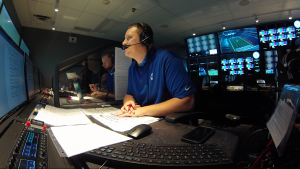
Baltimore Colts’ Matt Taylor (foreground) and company call the season opener against the Jacksonville Jaguars from Lucas Oil Stadium.
“We set up that show very much with the look of our videoboard show,” says Allan Werthheimer, director, production operations, Minnesota Vikings. “Anyone who has ever been to U.S. Bank Stadium knows we have our main videoboard and, next to it, what we call our ‘wing boards.’ We replicated that in our stream. That L Bar was treated as an LED board, and we took things that we usually do in-stadium and moved them to the stream to make good on all of those sponsorships.”
Digital content isn’t the only method of entertainment for fans watching from home. Stevens and his team are taking it one step further when the Colts are on the road. For the squad’s first road game in Jacksonville (and for other subsequent away matchups throughout the season, radio calls are being produced remotely from the control room in Indianapolis.
“We have our entire radio broadcast of play-by-play Matt Taylor, color commentator Rick Venturi, and sideline reporter Larra Overton inside of the control room in Indianapolis,” he says. “The NFL was very open to letting us take feeds from CBS, Fox, ESPN, or NBC, and feeding it back to us via The Switch. We’ve also been working with local engineers at the stadiums to get the All-22 feed, crowd sounds, and referee microphones.”
A Quiet Debut: Los Angeles Chargers Open SoFi Stadium in Front of Empty Seats
The biggest causality throughout this peculiar season is the inability for fans to see the league’s newest buildings: SoFi Stadium in Los Angeles and Allegiant Stadium in Las Vegas. As the current home of the Los Angeles Chargers, the former of the two was built upon the knowledge and expertise used to construct another relatively new NFL venue: Mercedes-Benz Stadium in Atlanta, which opened in 2017.
A former member of that team, VP of Fan Experience and Executive Producer of Bolt Productions Pete Soto is now at the helm in this structure, and throughout his established career, he has never experienced a season opener as different as he did vs. the Chiefs on Sunday, Sept. 20.
“It was surreal because it felt like a rehearsal in a lot of ways,” he says. “I told Jason [Cothern, VP, broadcast and operations, SoFi Stadium and Hollywood Park] that this was probably the most relaxed opening event I’ve ever had in my career because our show was way less complex.”
Without a packed house, Soto and his team are using this time to learn the ins and outs of their new IP control room that is outfitted with 4K and HDR workflows.
“Technologically speaking, this control room is phenomenal,” notes Soto. “We had some technical issues, but our games have been very smooth. Our show at the stadium is a little bit different nowadays because we do it more in service of the players by giving them the things that they want.”
Collaborative Effort: Staffers Leverage Different Levels of Access
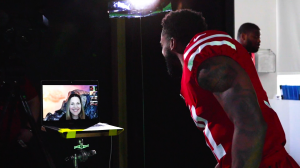
San Francisco 49ers’ Laura Johnson (on screen) speaks with running back Raheem Mostert via Zoom during a Media Day photoshoot.
Likewise to safety protocols seen in MLB control rooms, the tiering system has made its way to the ranks of professional football. In short, the tiering system allows a specific set of staffers with varying degrees of player and field access based on the credential that they were issued. In order for Tier 3 personnel (employees that are relegated to the press box or control room and restricted from field level) to obtain footage or material from Tier 2 (one level closer to the actual players), constant communication and proactive planning is put into place.
For example, the San Francisco 49ers’ Media Day looked a little different this year with some crew members being in the room with the players while others were pulling the strings remotely at home.
“Media Day was a little bit unconventional for us, so we had to get a little creative,” says Laura Johnson, director of game day presentation and live events, San Francisco 49ers. “I physically couldn’t be onsite because we could only have a certain amount [of onsite staffers], so I was there via Zoom coaching up our players and getting some lines over to them. It worked out really well and I think the guys got a good kick out of it and made them feel a little bit at ease.”
Although Johnson experienced a virtual Media Day, others are joining their respective teams for the first time during the COVID-19 pandemic. For example, Director/Executive Producer of Game Presentation Mike Bonner joined the Carolina Panthers before the pandemic made its way stateside. In the midst of transitioning from his former job as Executive Producer of Live Events for the University of Notre Dame, remote production became his lifeline to the organization.
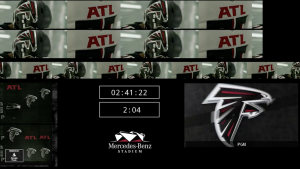
AMB Sports + Entertainment is relying on technological innovation to overcome COVID-19 restrictions.
“I started in January and I was getting to know the new staff and how things operate, but when COVID-19 hit [the United States] and we were told to work from home, we didn’t know how long that was going to last,” he says. “At that time, home for me was still in South Bend since my wife and children were back in Indiana finishing out the school year.”
In addition to intrapersonal collaboration, teams are adopting different modes of technology to keep up with the frenetic pace of changes. In Atlanta, AMB Sports + Entertainment (AMBSE), the entity responsible for production elements in Mercedes-Benz Stadium, is utilizing TVU Networks for rapid content sharing.
“Technology is constantly changing, and right now, one of the things that we love to do is continuously innovate,” says Ben Dolinky, chief broadcast and AV engineer, AMBSE. “We’re always looking for what’s next and how we can improve, so regardless of COVID-19 or not, we’re always looking to push the envelope to enhance that game day experience for our fans.”
